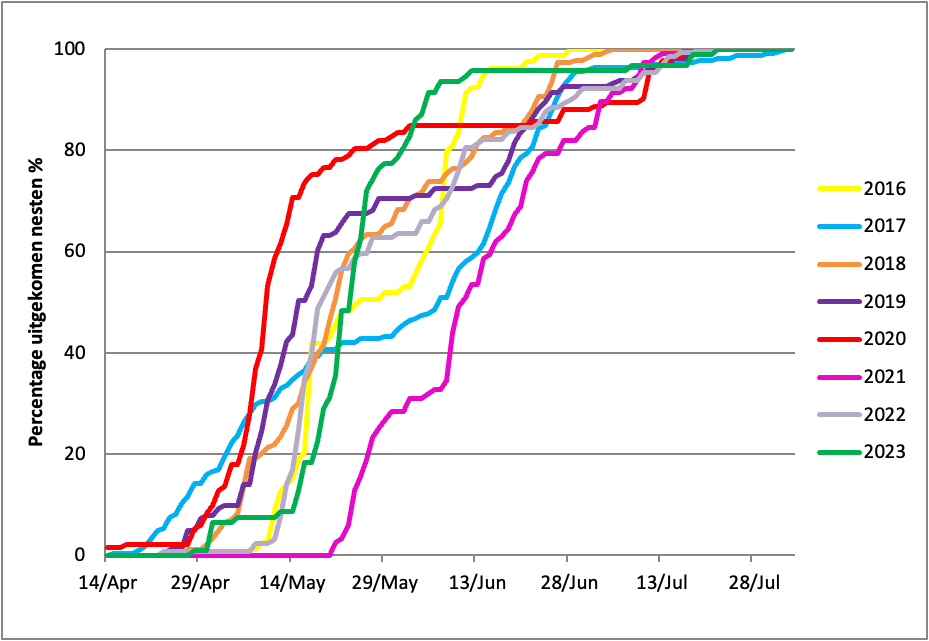by Petra de Goeij, Marycha Franken & Wouter Vansteelant
While most of our Spoonbills are currently in warmer regions of southern Europe and NW Africa, the Spoonbill team is looking back on a successful field season in the Netherlands past summer, including some nice media appearances, while also looking ahead to expanding its research efforts as part of the WAAKVOGELS project in 2024.
In 2023 no less than 671 Spoonbill chicks were ringed in the Netherlands by Werkgroep Lepelaar, in close collaboration with BirdEyes, regional conservation organisations, numerous volunteers, and with the help of the skippers of the Asterias and the Harder that kindly bring us to the insular colonies each year. Some 145 of these chicks were ringed at our main study island of Schiermonnikoog, in the eastern Wadden Sea. But as part of a systematic effort, chicks were ringed on almost all of the insular colonies in the Wadden Sea (incl. those on uninhabited islets like Griend), and in colonies further south near Amsterdam and in the province of Zeeland.

Besides our extensive ringing efforts, we also deployed 24 GPS-trackers on five adult and 19 juvenile birds from colonies on Schiermonnikoog, Texel and at Kinseldam near Amsterdam. As always, data are streamed directly into the global animal movement databank “Movebank”, allowing to follow the spoonbills in near real-time through the Animal Tracker app. In addition, everyone can browse through recent and historical Spoonbill tracking data through our very own Global Flyway Network website.During one of the ringing expeditions we were joined by Rob Buiter who wrote a beautiful article in Trouw and conducted a radio-interview with our field-coordinator Petra de Goeij for Vroege Vogels (both in Dutch). In the interview, Petra explained the scientific motivation for the ringing and tracking work, as well as the ethical considerations surrounding the field work. Later in the summer, Petra was interviewed by RTV Noord, where she explained how tracking allows us to listen to Spoonbills as sentinels of the Wadden Sea ecosystems, pointing to conservation challenges and successes. In coming years, we’ll be scaling up our tracking efforts to track Spoonbills from more colonies, enabling us to link breeding success to diet and movement strategies across different environments.

Based on the tracking data of these birds, we can already say there was a marked delay in the Spoonbill migration in autumn 2023. Many birds only left the Netherlands at the end of October, when spectacular mass departures of Spoonbills were also noted by birdwatchers along the Dutch coast. By the end of November several birds were still in the Netherlands, and more than half were staying on the Atlantic coast of France and northern Spain. In previous years, the bulk of the Spoonbills had reached their final non-breeding destinations in SW Portugal, S Spain and NW Africa by that time.
The delay was also noted by many observers in our international network of ring-readers, who eagerly await the arrival of the Spoonbills every autumn. By reading the colour-rings of Spoonbills, these volunteer observers contribute extremely valuable data that allows us to not only monitor the movements of our Spoonbills, but also to estimate their survival rates. As such, ringing and tracking efforts provide complementary information to piece together a detailed picture of the annual cycle of the Dutch Spoonbill population.
It has been over a decade since the last comprehensive analyses of Spoonbill ringing data by Tamar Lok. Back then, most Spoonbills migrated to sub-Saharan West Africa, even though Spoonbills that stayed in Europe survived better. In line with these insights from ringing data, a large portion of the birds that we tracked with transmitters a decade ago migrated to West Africa. Nowadays, however, almost all our GPS-tracked birds stay north of the Sahara throughout the non-breeding season, suggesting a shift has occurred in Spoonbill migration behaviour, and therefore -possibly- their survival. As such it’s high time for an update of Lok et al. 2011, which is one of several Spoonbill studies we’ll be conducting as part of the WAAKVOGELS project in coming years.



